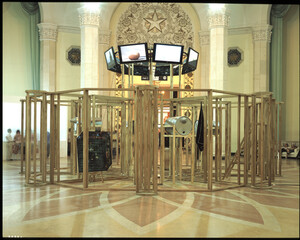Group Exhibition James Cohan Gallery Shanghai
zd
Experimental narrative modes are notable in the ambitious nine-channel video installation The Dream of Yabulai (2008) by Shanghai-based Zhang Ding. This work has been re-orchestrated as a site-specific work and is situated under the gallery's staircase. The supporting structure of the work is an open wooden lattice framework suggesting unfinished architecture. Within the framework are the nine video screens. The central screen shows a monkey assigning identify-specific props or costumes to eight actors who then assume their new roles on one of the individual screens. The subsequent eight different role-plays depict various themes, unveiling a composite of new behavior in a "micro-society" while attempting to visualize key ideas or events in human history, such as mapping territory, the creation of theory, science, energy, art, religion and war.
-----
Morakot (Emerald)(2007), a video installation by the award-winning Thai filmmaker-video artist Apichatpong Weerasethakul, intertwines memory with intimate experience. Morakot is a derelict hotel in the heart of Bangkok that opened in the 1980s when Thailand experienced accelerated economic growth and Cambodians poured into Thai refugee camps after the devastating conflict between Vietnamese and Cambodian forces. The setting is a dilapidated hotel room filled with floating feathers and haunted by ghostly figures in bed. Inspired by the Danish writer Karl Gjellerup's 1906 Buddhist novel, The Pilgrim Kamanita, the protagonists are reincarnated as two celestial stars who re-tell their stories to each other until they no longer exist. Morakot revisits fictitious memories bound to the history of the hotel through three voiceovers, each whispering their sorrows and eternal wait for love.


